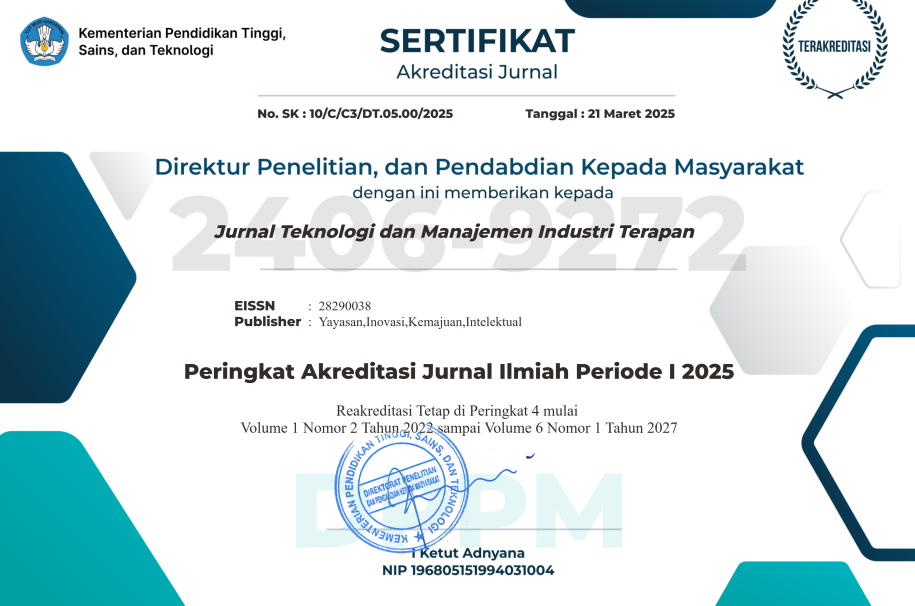Perancangan Strategi Pemasaran Produk pada Kelompok UPPKS di Kota Pekanbaru Menggunakan Pendekatan Marketing Mix dan TOPSIS
DOI:
https://doi.org/10.55826/jtmit.v4iI.1125Keywords:
marketing mix, metode topsis, strategi pemasaran, uppksAbstract
UPPKS (Usaha Peningkatan Pendapatan Keluarga Sejahtera) merupakan kegiatan ekonomi produktif yang bertujuan meningkatkan pendapatan keluarga sejahtera dalam bentuk kelompok di lingkungan masyarakat sederhana. Permasalahan utama yang dihadapi kelompok UPPKS di Kota Pekanbaru adalah lemahnya penetrasi pasar serta terbatasnya jangkauan wilayah pemasaran. Berdasarkan hasil wawancara yang dilakukan dengan pengurus kelompok UPPKS, strategi pemasaran produk yang diterapkan saat ini dinilai belum efektif, karena masih banyak masyarakat di Pekanbaru yang belum mengetahui keberadaan kelompok UPPKS. Tujuan dari penelitian ini adalah untuk mengetahui faktor-faktor yang mempengaruhi usaha kelompok UPPKS dengan menggunakan uji t, serta merancang strategi pemasaran produk UPPKS menggunakan pendekatan bauran pemasaran 4P (Product, Price, Promotion, Place) dan metode TOPSIS. Hasil uji t menunjukkan bahwa variabel promosi dan lokasi memiliki pengaruh signifikan terhadap kinerja pemasaran. Kedua variabel ini kemudian dijadikan alternatif utama dalam penentuan strategi pemasaran melalui analisis metode TOPSIS. Hasil perhitungan dan analisis menunjukkan bahwa strategi promosi menjadi alternatif terbaik dengan nilai preferensi tertinggi sebesar 0,73. Dengan demikian, strategi promosi dipilih sebagai pertimbangan utama dalam meningkatkan pemasaran produk kelompok UPPKS di Kota Pekanbaru.
References
D. Kurniawan and M. Mudiantono, “Analisis Pengaruh Inovasi Dan Keunggulan Bersaing Sebagai Variabel Intervening Orientasi Pasar Dan Penggunaan Erp Terhadap Kinerja Pemasaran (Studi Pada Usaha Mikro Kecil dan Menangah di Kota Semarang).” Fakultas Ekonomika dan Bisnis, 2018.
H. S. Ng and D. M. H. Kee, “Entrepreneurial SMEs surviving in the era of globalization: Critical success factors,” in Global opportunities for entrepreneurial growth: Coopetition and knowledge dynamics within and across firms, Emerald Publishing Limited, 2017.
N. A. Adam, “Innovation practices for survival of small and medium enterprises ( SMEs ) in the COVID-19 times : the role of external support,” vol. 6, 2021.
D. Diniaty, A. M. Fauzi, T. C. Sunarti, S. Raharja, and F. Helmi, “Determination of Superior Commodities For The Development of Small and Medium Industries in Kampar Regency,” J. Appl. Eng. Technol. Sci., vol. 5, no. 2, pp. 995–1010, 2024.
Z. Wasik, K. C. Nugroho, and D. Iswanto, “Improving UMKM Marketing Performance by Optimising Marketing Strategy, Creative Product Innovation and Market Orientation,” J. Manag. Sci. Stud., vol. 1, no. 2, pp. 1–21, 2023.
M. Mansuri, “Perancangan Dan Pembuatan Alat Vakum Pembersih Engine Cleaner Pada Ruang Bakar Mobil (Studi Kasus di CV. DUTA BAYU MOBIL Surabaya).” UNIVERSITAS 17 AGUSTUS 1945, 2018.
N. Iheanachor, I. O. Umukoro, and O. David-West, “The role of product development practices on new product performance: Evidence from Nigeria’s financial services providers,” Technol. Forecast. Soc. Change, vol. 164, p. 120470, 2021, doi: https://doi.org/10.1016/j.techfore.2020.120470.
S. Auh and O. Merlo, “The power of marketing within the firm: Its contribution to business performance and the effect of power asymmetry,” Ind. Mark. Manag., vol. 41, no. 5, pp. 861–873, 2012, doi: https://doi.org/10.1016/j.indmarman.2011.09.021.
C. Harini, “Meningkatkan Kinerja Pemasaran UMKM Kota Semarang melalui Strategi Penetrasi Pasar,” Ikra-Ith Ekon., vol. 2, no. 1, pp. 59–66, 2019.
A. Arvianto, D. P. Sari, and G. Olivia, “Pemilihan Strategi Pemasaran Pada PT. Nyonya Meneer Dengan Menggunakan Pendekatan Metode Analytical Network Process (ANP) dan Technique for Order Preference By Similarity to an Ideal Solution (TOPSIS),” Jati Undip, vol. 9, pp. 35–44, 2014.
L. Lamberti and G. Noci, “Marketing strategy and marketing performance measurement system: Exploring the relationship,” Eur. Manag. J., vol. 28, no. 2, pp. 139–152, 2010, doi: https://doi.org/10.1016/j.emj.2009.04.007.
Y. Gao, “Measuring marketing performance : a review and a framework,” no. March 2010, 2016, doi: 10.1362/146934710X488924.
A. Pimenta da Gama, “Measuring marketing performance: a better model,” J. Bus. Strategy, vol. 45, no. 4, pp. 230–238, Aug. 2023, doi: 10.1108/JBS-05-2023-0091.
J. Mani, “Pengaruh Peran Nilai Pelanggan Dan Citra Merek Terhadap Kinerja Pemasaran,” J. Mandiri Ilmu Pengetahuan, Seni, dan Teknol., vol. 2, no. 2, pp. 263–280, 2018.
A. Ferdinand, “Manajemen pemasaran: Sebuah pendekatan stratejik,” Res. Pap. Ser., vol. 1, pp. 1–55, 2000.
R. Lestari, B. M. Wibawa, F. Endayani, S. Aditua, and F. Silalahi, “Confirmatory factor analysis of marketing performance dimensions : a lesson from SMEs in Malang , Indonesia,” Cogent Bus. Manag., vol. 11, no. 1, p., 2024, doi: 10.1080/23311975.2024.2310084.
A. Anggito and J. Setiawan, Metodologi penelitian kualitatif. CV Jejak (Jejak Publisher), 2018.
C. L. Cummings, “Cross-sectional design,” SAGE Encycl. Commun. Res. Methods. Thousand Oaks SAGE Publ. Inc. Retrieved, 2018.
T. Imaliya, E. Zusrony, A. S. Ramadhan, and A. U. Nisa, “The Effect Of Digital Marketing , Demography , And Human Resources Competency On The Marketing Performance Of The Uppks Group Of Bergas Sub- District In The Time Of Covid-19 Recovery,” vol. 2022, no. 4, pp. 1989–2000, 2022.
N. I. Majdina, B. Pratikno, and A. Tripena, “Penentuan ukuran sampel menggunakan rumus Bernoulli dan Slovin: Konsep dan aplikasinya,” J. Ilm. Mat. Dan Pendidik. Mat., vol. 16, no. 1, pp. 73–84, 2024.
M. M. Rahman, “Sample size determination for survey research and non-probability sampling techniques: A review and set of recommendations,” J. Entrep. Bus. Econ., vol. 11, no. 1, pp. 42–62, 2023.
M. A. Memon, R. Thurasamy, H. Ting, and J.-H. Cheah, “Purposive sampling: A review and guidelines for quantitative research,” J. Appl. Struct. Equ. Model., vol. 9, no. 1, pp. 1–23, 2024.
D. Diniaty, S. T. M. E. Dev, and D. S. Mahmud, “Perencanaan Strategi Pemasaran Telur Ayam Untuk Meningkatkan Penjualan Pada Peternakan Budi Daya Alam Lestari Dengan Metode Marketing Mix Dan Topsis,” vol. 4, no. 2, pp. 91–100, 2018.
P. Kotler and G. Armstrong, “Principle of Marketing. 15?ℎ edition. New Jersay.” Pearson Prentice Hall, 2016.
D. Caesaron, “Penentuan strategi pembinaan UMKM provinsi DKI Jakarta dengan menggunakan metode AHP TOPSIS,” J. Metris, vol. 15, no. 2, pp. 77–82, 2014.
Y. Utami, “Uji Validitas dan Uji Reliabilitas Instrument Penilaian Kinerja Dosen,” J. Sains Dan Teknol., vol. 4, no. 2, pp. 21–24, 2023.
Y. Faisal, I. Indriyani, T. Mayang, and A. Muhamad, “Pengaruh Kompetensi Sumber Daya Manusia Dan Sistem Informasi Akuntansi Terhadap Kualitas Laporan Keuangan,” J. Maneksi (Management Ekon. Dan Akuntansi), vol. 12, no. 1, pp. 176–185, 2023.
Z. Mo et al., “Reliability and validity of a questionnaire measuring knowledge, attitude and practice regarding ‘oil, salt and sugar’ among canteen staff,” Sci. Rep., vol. 13, no. 1, p. 20442, 2023, doi: 10.1038/s41598-023-47804-3.
S. G. Kwak and S.-H. Park, “Normality test in clinical research,” J. Rheum. Dis., vol. 26, no. 1, pp. 5–11, 2019.
P. Mishra, C. M. Pandey, U. Singh, A. Gupta, C. Sahu, and A. Keshri, “Descriptive statistics and normality tests for statistical data,” Ann. Card. Anaesth., vol. 22, no. 1, pp. 67–72, 2019.
I. Ghozali, “Aplikasi Analisis Multivariate dengan Program SPSS [Multivariate Analysis Application with SPSS Program],” Semarang Badan Penerbit Univ. Diponegoro, 2009.
J. Song, “Application of hypothesis testing in estimating regression models,” vol. 0, pp. 165–171, 2024, doi: 10.54254/2753-8818/39/20240596.
J. Gao, “R-Squared ( R ) – How much variation is explained ?,” 2024, doi: 10.1177/26320843231186398.
K. Kumari and S. Yadav, “Linear Regression Analysis Study,” J. Pract. Cardiovasc. Sci., vol. 4, no. 1, 2018, [Online]. Available: https://journals.lww.com/jpcs/fulltext/2018/04010/linear_regression_analysis_study.9.aspx.
D. Diniaty, I. Kusumanto, F. Roza, and F. D. Husna, “JKBM Analisis Strategi Pemasaran dalam Upaya Meningkatkan Analysis Strategy Marketing in an Effort to Increase Sales Salai,” vol. 6, no. November, pp. 109–120, 2019, doi: 10.31289/jkbm.v512.3080.
K. N. Lemon and P. C. Verhoef, “Understanding customer experience throughout the customer journey,” J. Mark., vol. 80, no. 6, pp. 69–96, 2016.
E. A. Sari and L. S. Wijaya, “Strategi Promosi Melalui Direct Marketing Untuk Meningkatkan Jumlah Mahasiswa Baru,” pp. 16–27, 2019.
E. S. Alghifari, R. Hurriyati, and P. D. Dirgantari, “Strategi Promosi melalui Media Sosial dan Electronic Word of Mouth untuk Komunikasi Konsumen Promotion Strategy through Social Media and Electronic Word of Mouth for Consumer Communication,” vol. 8, no. 2, pp. 114–127, 2022, doi: 10.31289/jkbm.v8i2.6267.
A. Muhajir, “Pengaruh Digital MarketingDan Strategi Promosi Terhadap Peningkatan Penjualan Pada CV. Sinar Terang Gresik,” vol. 5, no. 2, pp. 36–50, 2022.
C. B. Iloka, “The Concept of Experiential Marketing : A Comprehensive Review,” no. August, 2024.
A. R. Elahi, “The Effectiveness of Promotion through Brochure Advertising on Merchandise Sales : A Case Study of Multiple Retail Stores of Pakistan,” no. October, 2023, doi: 10.5281/zenodo.8370964.
Z. Zhou, “Destination Marketing : Measuring the Effectiveness of Brochures Destination Marketing : Measuring the Effectiveness of Brochures,” no. September 1997, 2016, doi: 10.1300/J073v06n03.
S. Irawan and U. I. Indonesia, “The Effect Of Promotions , Discounts And Service Quality In Repurchasing Interest In Grabfood Ap-,” vol. 4, no. 2, pp. 515–524, 2023.
Downloads
Published
Issue
Section
License
Copyright (c) 2025 Dewi Diniaty, Muhammad Nur

This work is licensed under a Creative Commons Attribution-NonCommercial-ShareAlike 4.0 International License.


















